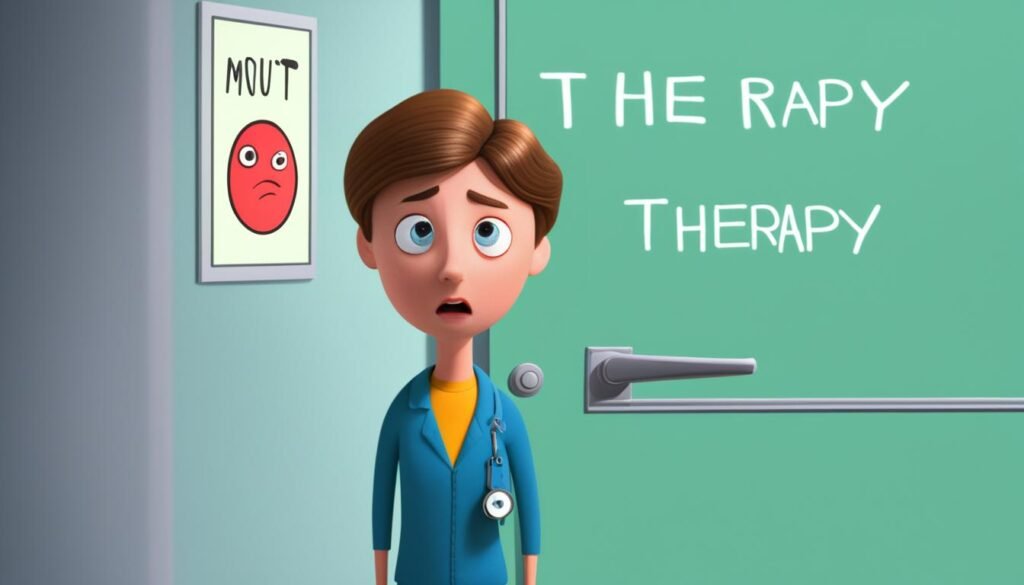Social anxiety, also known as social phobia, affects millions worldwide. It makes people fear social situations deeply. This leads to shyness, avoiding others, and physical symptoms like sweating and blushing. Luckily, cognitive behavioral therapy (CBT) is a proven way to help.
CBT is the top choice for treating social anxiety disorder. This serious form of social anxiety affects over 12% of adults in the U.S. The therapy helps people change negative thoughts that cause their anxiety. It also helps them face their fears and learn better ways to cope.
Understanding social anxiety’s thought patterns helps us change our negative beliefs. We can replace them with more realistic and positive ones. Exposure therapy helps us get used to situations that once made us anxious. This way, we can gain confidence and take back control of our lives.
We will look closer at social anxiety’s symptoms and how common it is. We’ll also explore the cognitive-behavioral approach to treating it. Plus, we’ll see which techniques work best for overcoming this condition. Let’s discover how cognitive behavioral therapy can change lives.
Table of Contents
ToggleUnderstanding Social Anxiety Disorder
Social anxiety makes people feel very worried and nervous in social situations. They worry about what others think of them. They think they might embarrass themselves or be rejected.
This fear can cause physical symptoms like sweating and blushing. It can make them avoid social situations, sticking to only a few close friends.
Symptoms and Manifestations
The symptoms of social anxiety can vary. They often include:
- Intense fear or anxiety in social situations
- Avoidance of social interactions or events
- Excessive self-consciousness and worry about being judged by others
- Physical symptoms such as blushing, sweating, and trembling
- Difficulty making eye contact or initiating conversation
- Feelings of panic or discomfort in crowded or public places
Social anxiety disorder can really affect someone’s life. It makes it hard to be social, keep relationships, and reach goals.
It’s important to understand social anxiety disorder to get the right help and support.
The Prevalence of Social Anxiety Disorder
Social anxiety disorder is a common mental health issue. It affects a big part of the population. The latest stats show it’s the third most common mental health issue among adults, with at least 5% of people worldwide dealing with it at some point.
This means one in every 20 people will face social anxiety disorder sometime in their lives. It doesn’t just affect one gender; both men and women can have it. Women are a bit more likely to have it, though.
People with social anxiety disorder often don’t get married and might have a lower income. Even though it’s common, many don’t get the help they need. This leaves many struggling with symptoms without the right support.
Knowing how common social anxiety disorder is helps us tackle this issue. By spreading awareness and making sure people get the right treatment, we can help those affected. They can feel more confident, live better lives, and enjoy social interactions more.
Cognitive Behavioral Therapy (CBT): A Proven Treatment
If you’re struggling with social anxiety, there’s good news – cognitive behavioral therapy (CBT) can help. It’s a scientifically proven method that targets negative thought patterns and behaviors. CBT helps you take back control of your life.
CBT believes that our thoughts, feelings, and actions are linked. With a therapist’s help, you can spot irrational beliefs and negative thinking that cause anxiety. Then, you can change these thoughts to more positive and realistic ones.
But CBT does more than just change your thoughts. It also involves facing your social fears in a safe way. This helps you build confidence and learn how to handle anxiety in everyday life.
Working with a CBT therapist is a team effort. Together, you’ll create a plan that fits your specific needs. With time, effort, and support, many people find lasting relief from social anxiety.
If you’re ready to beat your social anxiety, talk to a qualified CBT therapist. They can guide you with proven CBT methods. You can start enjoying social life again and connect with others.
The Cognitive Model: Understanding the Thought Patterns
Cognitive behavioral therapy (CBT) shows us that our thoughts, feelings, and actions are linked. The cognitive model of social anxiety points out that our thoughts are the main cause of this disorder. People with social anxiety often think negatively and distortively, which makes their fears and anxieties worse.
Identifying Negative Thought Patterns
Those with social anxiety may have negative thought patterns. They might think the worst will happen, believe they’ll be judged or rejected, and see neutral interactions as proof of their failure.
Challenging and Replacing Irrational Beliefs
A key part of CBT is to challenge these wrong beliefs and replace them with more realistic ones. By spotting these distortions, people can learn to doubt their thoughts. They can then think in more balanced ways.
Cognitive Defusion
Cognitive defusion is another helpful method. It helps people step back from their anxious thoughts and beliefs. This reduces how much these thoughts affect them.
Understanding the cognitive model of social anxiety helps people see their anxiety better. By working to change negative thoughts, they can make big steps towards beating their anxiety.
Exposure Therapy: Confronting Social Fears
Exposure therapy is key in fighting social anxiety. It’s a method where you face your fears step by step. This helps you get used to your anxiety and gain confidence.
Through gradual exposure, you learn to face social situations instead of avoiding them. This breaks the cycle of avoiding things that make you fearful.
Gradual Exposure to Social Situations
Starting small is the first step in exposure therapy. We pick the social situations that make you most anxious. Then, we make a list of tasks, starting with the easiest and moving to the toughest.
This way, you build up your tolerance for anxiety. You also get better at handling your thoughts and feelings in social places.
Building Tolerance to Anxiety
Through exposure therapy, you learn that your anxious thoughts and feelings are under control. You find that the fear before a social event is often bigger than the event itself. With each challenge, you become more confident and resilient.
Embracing exposure therapy helps you face your social fears and gain confidence in social situations. It’s a tough but powerful method that has helped many people beat social anxiety disorder.
Mindfulness: A Powerful Tool for Self-Awareness
Exploring cognitive behavioral therapy (CBT) for social anxiety shows the power of mindfulness. This practice is key in CBT, helping people understand and control their anxiety.
Mindfulness makes us more aware of our thoughts, feelings, and body signals without judgment. This self-awareness helps us find the reasons for our social anxiety. It also helps us handle our experiences better.
With mindfulness, we watch our thoughts and feelings without getting lost in them. This creates space to question and change our anxious thoughts. It makes it easier to fight off thoughts that make us anxious.

Also, mindfulness teaches us to be kind and understanding to ourselves. As we know ourselves better, we can face our social fears with kindness, not self-criticism.
Adding mindfulness to our CBT helps us grow in self-awareness and acceptance. This approach to dealing with social anxiety can bring lasting, positive changes to our lives.
cognitive behavioral therapy for social anxiety
Cognitive Behavioral Therapy (CBT) is the top treatment for social anxiety disorder. It helps people with social anxiety take back control of their lives. They learn to face their fears and handle social situations better.
CBT shows that our thoughts, feelings, and actions are linked. People with social anxiety often think too badly about social events. CBT teaches them to question these negative thoughts and think more realistically.
Exposure therapy is a big part of CBT for CBT for social anxiety. It involves facing the social situations that scare you, but in a safe way. This helps people get used to their fears and feel more confident.
CBT also uses mindfulness. This means paying attention to the present moment and understanding your thoughts and feelings. It helps people make better choices in social situations.
Many studies have shown that CBT works well for social anxiety. It reduces symptoms and improves life quality for those with social anxiety disorder.
CBT for social anxiety is a powerful way to deal with social anxiety. It helps people face their fears and connect with others. It makes life more fulfilling.
The Effectiveness of CBT for Social Anxiety
Many studies show that cognitive behavioral therapy (CBT) is a top choice for treating social anxiety disorder. It helps most people see big improvements in their symptoms and how they handle social situations. This therapy is based on solid evidence.
CBT for social anxiety is different from other forms of therapy. It’s active, short, and lets people help themselves. By changing negative thoughts, facing their fears, and learning new ways to cope, people with social anxiety can get better. They also become more resilient over time.
Research on CBT for social anxiety is very positive. Up to 75% of patients see a big drop in their social anxiety after completing CBT. They also enjoy better life quality, better social skills, and more confidence in social settings.
One big plus of CBT is that the changes stick around. Unlike medication, which might only help for a little while, the skills from CBT last. This means people can keep managing their social anxiety on their own. They feel more in control and confident.

In short, research proves that cognitive behavioral therapy is a great way to deal with social anxiety. It targets the thoughts and actions that cause social anxiety. This leads to lasting improvements for those facing this common mental health issue.
Common CBT Techniques for Social Anxiety
Cognitive Behavioral Therapy (CBT) is a top way to tackle social anxiety. It helps people face their social fears and anxieties. Let’s look at some key CBT techniques that can help.
Psychoeducation
Psychoeducation is key in CBT. It teaches people about social anxiety’s mental parts. This includes thoughts, feelings, and actions that make it worse. By understanding this, people can tackle the real causes of their anxiety.
Cognitive Restructuring
CBT techniques for social anxiety include cognitive restructuring. This method helps change negative, wrong thoughts that cause anxiety. By thinking more realistically, people can stop the cycle of anxiety and think healthier.
Systematic Desensitization
Exposure therapy, or systematic desensitization, is a big part of CBT for social anxiety. It slowly gets people used to the situations they fear. This builds confidence and tolerance over time. Facing fears in a safe place helps people deal with their anxiety better.
Behavioral Experiments
Cognitive restructuring goes hand in hand with behavioral experiments. These experiments test negative beliefs and behaviors. They give people useful feedback, showing that their fears and avoidance are often too much.
Using these CBT techniques, people with social anxiety can find better ways to cope. They become more aware of themselves and improve their social life and well-being.
Seeking Professional Help for Social Anxiety
If you or someone you know is struggling with social anxiety, getting help can change everything. A mental health expert, like a therapist or psychologist, can help. They can make a plan just for you using proven methods like cognitive behavioral therapy (CBT).
Finding a therapist for social anxiety might seem hard, but it’s key for your mental health. It’s important to find someone who knows about social anxiety and uses CBT and other effective methods.
- Look for therapists who have expertise in treating social anxiety disorder and are trained in CBT techniques.
- Ask about their approach to therapy and how they incorporate exposure therapy, cognitive restructuring, and other evidence-based strategies.
- Consider factors such as the therapist’s location, availability, and whether they accept your health insurance or offer sliding-scale fees.
Remember, asking for help is a big step towards beating social anxiety. With the right support and treatment, you can get better at handling social situations. This can make your life much better overall.

Conclusion
Cognitive Behavioral Therapy (CBT) is now the top treatment for social anxiety disorder. It helps people change their negative thoughts and face their fears step by step. CBT also teaches better ways to cope with anxiety.
This therapy has shown to be very effective. It gives us the tools to take back our lives and connect with others more deeply. We become more confident and happy because of it.
If you or someone you know is struggling with social anxiety, there is hope. Effective treatment is out there. With the help of a mental health expert and CBT, we can break through social barriers. This opens up a world of new possibilities.
FAQ
What is social anxiety disorder?
Social anxiety disorder, also known as social phobia, is a common mental health issue. It makes people fear social situations deeply. They might feel shy, avoid social interactions, and show signs like sweating and blushing.
What are the symptoms of social anxiety disorder?
People with social anxiety disorder feel extreme worry and nervousness in social settings. They worry about how others see them. They fear embarrassing themselves, feeling self-conscious, and being rejected or laughed at.
How prevalent is social anxiety disorder?
Social anxiety disorder is one of the most common mental health issues in adults. It affects at least 5% of people worldwide. It happens in both men and women, with women being slightly more affected.
What is the most effective treatment for social anxiety disorder?
Cognitive Behavioral Therapy (CBT) is the top treatment for social anxiety disorder. It helps people change negative thoughts, face their fears, and learn better ways to cope.
How does the cognitive model of CBT address social anxiety?
The cognitive model of CBT says social anxiety comes from negative and wrong thoughts. CBT helps people spot and question these thoughts. It offers more realistic views to replace them.
What is the role of exposure therapy in CBT for social anxiety?
Exposure therapy is key in CBT for social anxiety. It slowly helps people face their fears in social situations. This makes them less anxious and builds confidence over time.
How does mindfulness contribute to CBT for social anxiety?
Mindfulness is a big part of CBT for social anxiety. It helps people understand and handle their anxiety better. By being mindful, they learn to notice their thoughts and feelings without judgment.
What are some common CBT techniques used for social anxiety?
Common CBT methods for social anxiety include learning about the condition, changing negative thoughts, and facing fears. These help people spot and fight negative thoughts, overcome fears, and find better ways to cope.
How can someone seek professional help for social anxiety disorder?
If you or someone you know has social anxiety, getting professional help is key. A mental health expert, like a therapist or psychologist, can create a plan tailored to your needs. They use proven CBT methods.
Source Links
- https://cogbtherapy.com/cbt-for-social-anxiety-disorder – Cognitive Behavioral Therapy CBT for Social Anxiety Disorder Los Angeles
- https://www.ncbi.nlm.nih.gov/pmc/articles/PMC3016703/ – Cognitive behavioral therapy in the treatment of social phobia
- https://www.healthline.com/health/anxiety/social-anxiety-disorder-cognitive-behavioral-therapy – Cognitive Behavioral Therapy (CBT) for Social Anxiety: How It Works
About The Author

This article is medically reviewed by Dr. Chandril Chugh, Board-Certified Neurologist, providing expert insights and reliable health information.
Dr. Chandril Chugh is a U.S.-trained neurologist with over a decade of experience. Known for his compassionate care, he specializes in treating neurological conditions such as migraines, epilepsy, and Parkinson’s disease. Dr. Chugh is highly regarded for his patient-centered approach and dedication to providing personalized care.
→ Book a consultation to discover which remedies suit your needs best.




